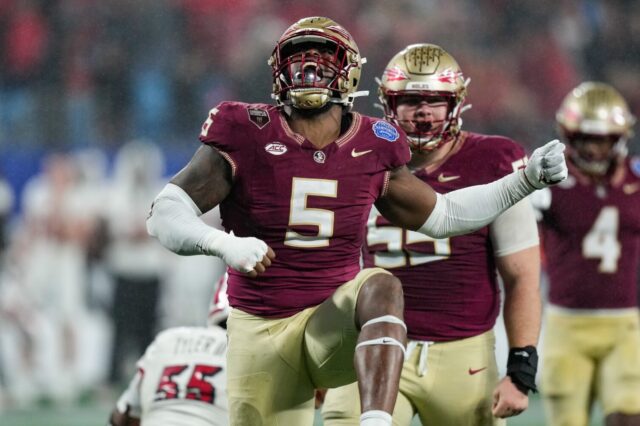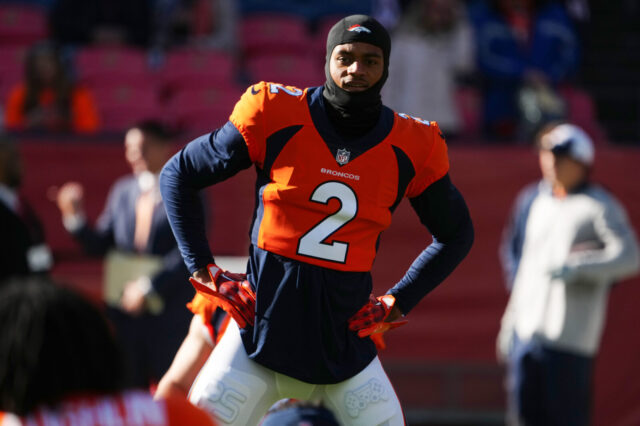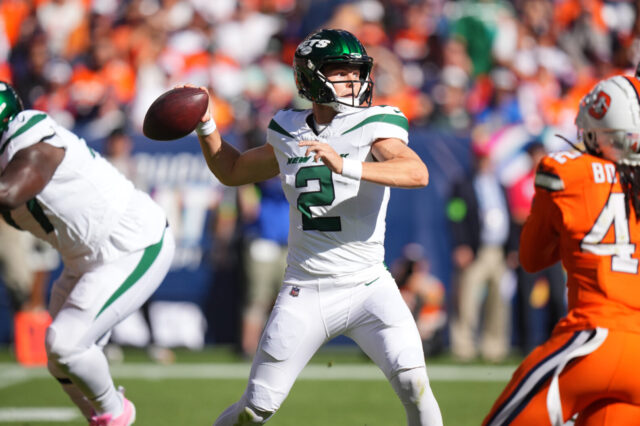Today, the Broncos’ organized team activities (also known as OTAs) kick off, which means real football is right around the corner. That also means it’s time to figure out what this Broncos roster will look like come Week 1.
Here, we’ll preview every battle on offense you’ll see at training camp, who is most likely to win it, and whether or not that result will hold throughout the season.
Quarterback: Drew Lock vs. Teddy Bridgewater
Starting off with the marquee competition at quarterback, which unfortunately figures to be much less intriguing than once anticipated, as the outcome is more or less decided.
Teddy Bridgewater has a chance of winning the Week 1 starting job, but he would have to thoroughly beat Drew Lock in their camp battle to make that slim chance a reality.
This is because it is much easier to start the season with Lock — who entered the off-season holding the title of “Broncos starting quarterback” and has the potential to maybe one day be the long-term answer at the position — and then bench him for Bridgewater, rather than the other way around.
This is in part because of the team choosing to pass on two promising young quarterbacks in this year’s draft (Justin Fields and, to a lesser extent, Mac Jones).
Can you imagine the outrage if the team were to pass on Fields — a potential quarterback of the future — and then bench the only potential ‘quarterback of the future’ on the roster for Bridgewater before the season even starts? There’s no way George Paton and Vic Fangio put themselves in that position.
Now, once Lock wins the Week 1 starting job, all bets are off. Any point after Week 1, it wouldn’t be surprising in the slightest to see Lock benched. Outside of Denver, he’s viewed as one of the worst starting quarterbacks, and the roster is loaded everywhere but quarterback. They don’t have weeks to wait and see if it finally clicks for Lock, they need him to hit the ground running.
Lock will be the Week 1 starter, but his leash will be unbelievably short.
Running back: Melvin Gordon vs. Javonte Williams
The battle between Lock and Bridgewater will receive the lion’s share of the coverage and analysis, but as just stated, that competition is more performative than anything.
The competition you should really be watching is in the backfield.
Melvin Gordon might not be a superstar running back, but he is a high-end starter, so it will be difficult to unseat him.
Plus, the fact he was able to dodge a potential DUI suspension means that Javonte Williams won’t get the advantage of playing as the lone workhorse back for three weeks before splitting responsibilities with Gordon.
All that said, Williams is likely the better of the two backs at this point in their respective careers. Like many rookie running backs, Williams could enter the league and experience very little transition time, as running backs tend to see their skills translate to the NFL easier than other positions.
Running backs are rarely better than they are their first three years in the league, as they often peak early and then slowly decline. Gordon is in that decline, and by next season, the diminishing returns might not be enough to stave off a potential superstar like Williams.
One element that favors Gordon is his pass protection, which is certainly valuable, but Williams doesn’t trail too far behind in that aspect of the game, so it won’t buy the former Charger much security.
No. 3 Wide receiver: Tim Patrick vs. K.J. Hamler
As the old adage goes, “styles make fights” and there might not be a camp battle for the Broncos that pits two opposing styles against one-another quite like the competition between Tim Patrick and K.J. Hamler.
Courtland Sutton will certainly be the team’s No. 1 receiver and Jeudy will be the team’s No. 2, but might be best off operating out of the slot. That leaves the question though, who will be No. 3?
Patrick is likely entering his last season in Denver, while Hamler should stick around for a while, but it’s not like Patrick is a progress stopper. His 2020 season was tremendous. He showcased the skillset of a true ‘X’ receiver and fit well with Lock.
Meanwhile, Hamler is a much more dynamic and explosive weapon, but he struggled as a rookie and it’s fair to wonder if he’s a good fit for Lock’s traits. Lock can throw the ball over some mountains, a la Uncle Rico — which works with Hamler — but he is very imprecise, and Hamler is a precision weapon, as hinted at by his 5-foot-9, sub-180 pound frame.
Patrick’s size, physicality, wingspan and truly masterful hands are a better fit for a quarterback like Lock. He also looked like the much better receiver the last time we saw Hamler and him play, so expect Patrick to win that starting job while Hamler still sees a lot of playing time as a rotational weapon.
No. 3 Tight end: Troy Fumagalli vs. Eric Saubert vs. Austin Fort vs. Shaun Beyer
Noah Fant and Albert Okwuegbunam are the top two tight ends on the Broncos depth chart, but after them is a large drop-off in talent and a mystery as to who Denver’s third tight end could be.
One thing we do know, is that No. 3 tight end will have to be effective as a blocker to balance out the rest of the room. Fant has grown a ton as a blocker, but there’s still room for improvement and Okwuegbunam’s blocking is lacking, so adding more of an inline option behind them would be wise.
Noah Fant isn't just a straight athlete, he's growing into a true Y-TE that can set the edge and allow the offense to have confidence to run the ball his way – and also stay on the field for all 3 downs and help disguise any tendencies. pic.twitter.com/35z9YPS5Me
— Nate Tice (@Nate_Tice) May 20, 2021
For now, Troy Fumagalli is the leader in the clubhouse as he’s a very effective blocker who has proven to be a reliable — though ultimately unexciting — target in the passing game. He also saw his roll increase as the season went on, which bodes well and gives him some momentum to carry with him into camp.
Andrew Beck is very similar to Fumagalli, and also offers versatility as a fullback. However, it should be noted that as Fumagalli’s role in the offense increased, Beck’s decreased.
The other player in the room with past Broncos experience is Austin Fort, who has flashed in the preseason in past years, but has had nagging injury problems which could prevent him from being a legitimate competitor.
Eric Saubert might be able to catch on as a depth tight end, but he’s well-below-average as a blocker and has drop issues as a wide receiver. He’s the most bland of Denver’s tight end options, but arguably the most proven as well.
Last but not least is Shaun Beyer, who people shouldn’t sleep on. While some in Denver media were pining for Tim Tebow to try out tight end for the Broncos (what is wrong with you by the way?), they threw Beyer under the bus, labeling him as an ‘unexciting’ option.
But that’s just because they don’t have the faintest idea as to who Shaun Beyer is.
Beyer was a 6-foot-5, 200 pound wide receiver coming out of high school who Iowa moved to tight end. While at tight end, Beyer didn’t see much work in the passing game but was an excellent blocker for the Hawkeyes. Simply because he wasn’t targeted much at Iowa, there are concerns about his pass-catching ability, but his wide receiver past eases a lot of those concerns.
Warren Jackson has gotten a lot of pop recently, but Beyer is the undrafted free agent with the best chance of making the final roster.
With that in mind, Fumagalli should be considered the frontrunner for the No. 3 tight end role, but don’t make the mistake of counting out Beyer, as more foolish members of the Denver sports media already have.
Right Tackle: Calvin Anderson vs. Bobby Massie vs. Cameron Fleming
Bobby Massie and Cameron Fleming were signed in a panic after Ja’Wuan James tore his Achilles, so the Broncos would at least have someone on the roster with a considerable amount of starting experience at tackle.
Both are well past their prime, but Fleming was solid for the Giants last season and Massie has been a capable tackle for a long time, even if he’s coming off a disappointing season as a part of the Chicago Bears’ floundering offensive line.
Neither will be an above-average starter, and they both have very little upside, but they can be a safety net that prevents right tackle from being a disaster.
Also, don’t forget about Calvin Anderson, who has a bit more upside. The Broncos reportedly have a lot of faith in Anderson, and they were impressed by what he showed against the Carolina Panthers, when he was given very little notice that he would be starting.
As a result, this might be Anderson’s battle to lose. It would make sense for the Broncos to prefer rolling with Anderson — who could potentially grow into a starting tackle — as opposed to Fleming or Massie, who will be nothing more than a one-year band aid.
Center: Lloyd Cushenberry III vs. Quinn Meinerz
All the talk towards the end of the season, and entering the off-season, indicated the Broncos were still happy with Lloyd Cushenberry III, and expected him to turn it around in the upcoming season.
But then, they drafted the high-upside center project from Wisconsin-Whitewater, Quinn ‘The Gut’ Meinerz.
In all likelihood, this year’s battle will merely be an appetizer for competitions in upcoming seasons between Graham Glasgow, Netane Muti and Dalton Risner, as well as Cushenberry and Meinerz.
Denver has the good problem of having a lot of talented interior linemen, and not enough slots to play them. Whoever loses this camp’s competition at center, will find themselves at a disadvantage moving forward, especially if that loser is Cushenberry.
Fortunately for him though, Meinerz is very raw and has never had to face anything resembling the level of competition at the NFL level, which means he’ll probably need some time and that the LSU product will manage to retain his starting job.



